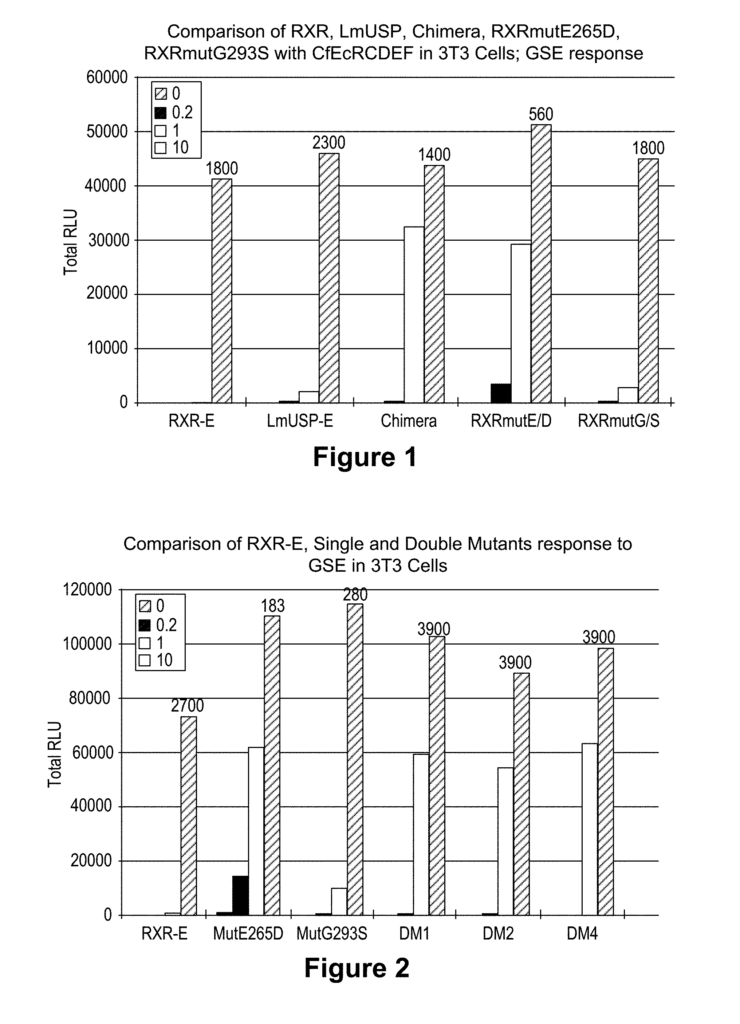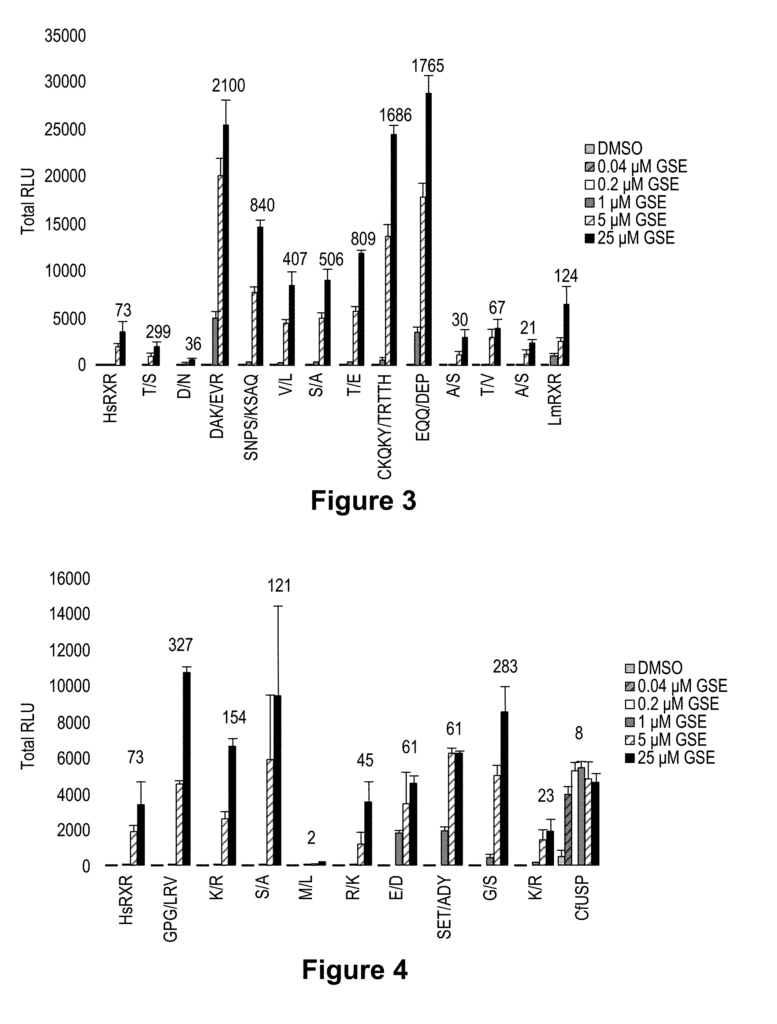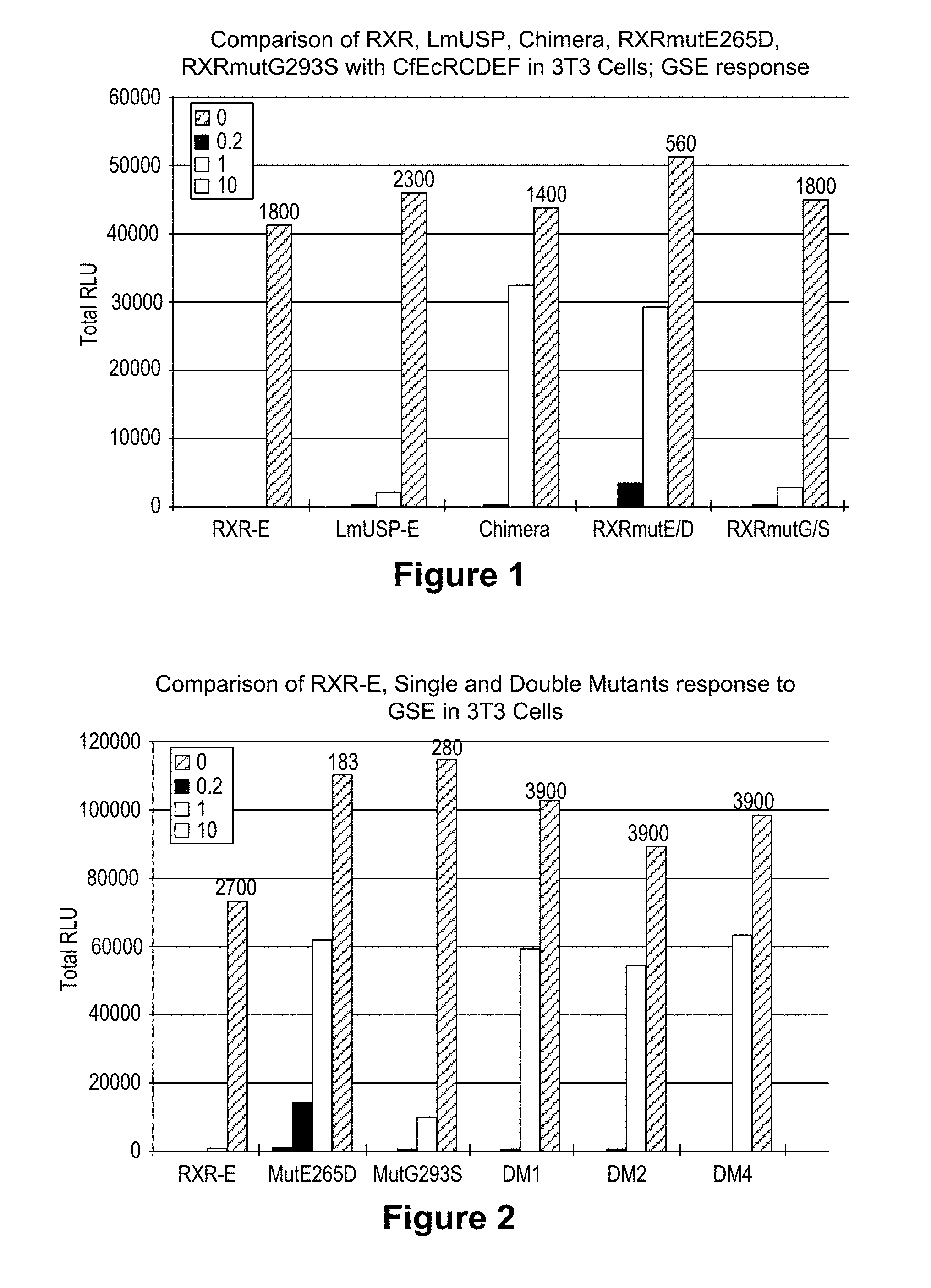Invented by Subba Reddy Palli, Marianna Zinovievna Kapitskaya, Precigen Inc
Gene expression is a fundamental process in molecular biology that allows the information encoded in genes to be converted into functional proteins. The ability to control gene expression is crucial for various research applications, including the study of gene function, drug discovery, and biotechnology. One powerful tool for regulating gene expression is the use of inducible systems, which allow researchers to turn genes on or off at specific times or in specific tissues.
One such inducible system is based on the ecdysone receptor, a protein found in insects that regulates the timing of developmental events. The ecdysone receptor can be engineered to respond to synthetic ligands, such as the insect hormone methoprene, instead of its natural ligand. This modified receptor, known as the ecdysone receptor-based inducible system, allows for precise control of gene expression in a wide range of organisms, including mammalian cells.
However, the ecdysone receptor-based inducible system has limitations. One major challenge is the lack of specificity of the synthetic ligands for the modified receptor. The synthetic ligands can also bind to endogenous receptors, leading to unintended gene expression. To overcome these limitations, researchers have developed substitution mutants of the ecdysone receptor that have improved ligand specificity and reduced cross-reactivity with endogenous receptors.
The market for substitution mutants receptors is growing rapidly as researchers recognize the need for more precise control over gene expression. These mutant receptors offer several advantages over the wild-type ecdysone receptor, including increased ligand specificity, reduced off-target effects, and improved inducibility. These features make substitution mutants receptors highly desirable for a wide range of applications, including basic research, drug discovery, and biotechnology.
In basic research, substitution mutants receptors enable researchers to study the function of specific genes by turning them on or off at specific times or in specific tissues. This allows for the investigation of gene function in a controlled manner, leading to a better understanding of biological processes. Substitution mutants receptors also have applications in drug discovery, where they can be used to screen for compounds that selectively activate or inhibit specific genes. This can lead to the development of novel therapeutics that target specific diseases or pathways.
In the field of biotechnology, substitution mutants receptors have the potential to revolutionize gene expression systems. Their improved ligand specificity and inducibility make them ideal for the production of recombinant proteins, where precise control over gene expression is crucial. The ability to tightly regulate gene expression can enhance protein yields, improve protein quality, and reduce the risk of unwanted side effects.
In conclusion, the market for substitution mutants receptors is expanding rapidly as researchers recognize the need for more precise control over gene expression. These mutant receptors offer improved ligand specificity, reduced off-target effects, and enhanced inducibility, making them highly desirable for a wide range of applications in basic research, drug discovery, and biotechnology. As the field of gene expression continues to advance, substitution mutants receptors are likely to play a crucial role in shaping the future of molecular biology.

The Precigen Inc invention works as follows
This invention is related to biotechnology or genetics. This invention is a part of the field gene expression. This invention is more specifically a novel nuclear receptor containing a mutation, and its use in an inducible system of gene expression based on nuclear receptors. It also relates to methods for modulating gene expression in host cells using this system.

Background for Substitution mutants receptors and their application in an ecdysone-receptor-based inducible system for gene expression
The disclosures in various publications are incorporated herein by reference. The citation of a reference in this document should not be taken as an admission that the reference is available for ‘Prior Art’. “The instant application.
In the field of genetics, precise control over gene expression can be a valuable tool to study, manipulate, and control development and other physiological functions. Gene expression is an intricate biological process that involves a variety of protein-protein interactions. A transcriptional activator that controls gene transcription must be brought close to a promoter in order for gene expression, and the production of the RNA required as the first stage in protein synthesis, to be triggered. The transcriptional activator is usually associated with a DNA-binding domain of a protein. This DNA-binding domain identifies DNA-binding sites in promoter regions. For gene expression to take place, a protein containing a DNA-binding domain and a transactivation region located at a suitable distance from the DNA-binding domain must be placed in the correct position within the promoter of the gene.
The traditional transgenic method uses a cell type-specific promoter to drive expression of the transgene. The transgene DNA construct is inserted into the host genome. Transgene expression occurs when a transcriptional activater triggers it in a specific cell type.
Inducible promoters are another way to regulate the expression of foreign genes within cells. Examples of the use of such inducible promoters include the PR1-a promoter, prokaryotic repressor-operator systems, immunosuppressive-immunophilin systems, and higher eukaryotic transcription activation systems such as steroid hormone receptor systems and are described below.
The PH1 promoter is induced by tobacco during the acquired systemic resistance response after pathogen attack. It is possible that the use of PR1a will be limited due to its tendency to respond to external and endogenous factors, such as pathogens and UV-B radiation. The use of gene regulation systems based upon promoters that are induced by heat, interferon, and heavy metals has been described (Wurn, et. al., Proc. Natl. Acad. Sci. USA 83: 5414-5418; Arnheiter et al., 1990, Cell 62: 51-61; Filmus et al., 1992 Nucleic Acids Research 20: 27550-27560). These systems are limited by their impact on the expression of non-targeted genes. These systems are also leaky.
The “Prokaryotic Repressor-Operator Systems” utilizes bacterial repressor protein and the unique operator DNA that they bind. The tetracycline molecule (?Tet?) Both the tetracycline (?Tet?) Repressor-operator system from Escherichia Coli has been used to control gene expression in animals and plants. In the Tet System, the TetR protein repressor is bound by tetracycline, which results in a conformational shift that frees the repressor from the operator, and allows transcription. In the Lac system, a lac operon is activated in response to the presence of lactose, or synthetic analogs such as isopropyl-b-D-thiogalactoside. The use of these systems is limited by the unstable chemistry of ligands. The use of such systems is restricted by the unstable chemistry of the ligands, i.e. “For similar reasons, the utility of these systems in animals is also limited.
Immunosuppressive molecule such as FK506, Rapamycin, and Cyclosporine A can bond to immunophilins FKBP12, cyclophilin etc. This information has led to a general strategy that can be used to combine any two proteins by simply placing FK506 onto each protein or by placing FK506 and cyclosporine on the other. The use of a synthetic homodimer (FK1012), or a compound resulting from the fusion of FK506 and cyclosporine, (FKCsA), can be used to induce dimerization. (Spencer, et. al. 1993, Science 262 1019-24, Belshaw, et. al. 1996, Proc Natl Acad Sci USA, 93:4604-7). The FKBP12 DNA binding domain, VP16 activator and cyclophilin fusion domains were used in combination with FKCsA to demonstrate heterodimerization of a reporter under the control of a Gal4-binding promoter. This system contains immunosuppressants which can cause unwanted side effects, and limit its use in various mammalian genes switch applications.
The use of steroid receptor systems and higher eukaryotic transcriptional activation systems was also made. The nuclear receptor superfamily includes steroid hormone receptors, which are found on both vertebrate and insectivorous cells. Due to the involvement of many natural biological pathways, the use of steroidal substances that activate receptors in order to regulate gene expression is restricted, especially in plants and mammal. To overcome these difficulties, an alternative system was developed using insect receptors for ecdysone (EcR).
Growth and development of insects are controlled by the ecdysone hormone (molting hormonal) and juvenile hormones” (Dhadialla et. al., 1998 Anna). Rev. Entomol. 43: 545-569). In insects, the molecular targets for ecdysone are at least ecdysone-receptor (EcR), and ultraspiracle (USP). EcR belongs to the nuclear steroid superfamily and is characterized by DNA and ligand-binding domains and an activation region (Koelle and al. 1991, Cell, 67:59-77). EcR receptors respond to a variety of steroidal substances such as muristerone and ponasterone. Recent studies have described non-steroidal substances with ecdysteroid receptor agonist activity, such as the insecticides methoxyfenozide and tebufenozide, which are available commercially and are sold worldwide by Rohm and Haas Company. PCT/EP96/00686 et U.S. pat. No. 5,530,028). The safety profile of both analogs is exceptional compared to that of other organisms.
The insect ecdysone (BR) receptor heterodimerizes Ultraspiracle, the insect homologue to the mammalian RXR. It binds ecdysteroid receptor response elements, activates transcription of ecdysone-responsive genes, and binds ecdysone and ecdysone receptive receptor response elements (Riddifod et. al., 2000). The EcR/USP/ligands complexes are important during insect development and reproductive processes. The EcR is a member of the steroid hormone receptor superfamily and has five modular domains, A/B (transactivation), C (DNA binding, heterodimerization)), D (Hinge, heterodimerization), E (ligand binding, heterodimerization and transactivation and F (transactivation) domains. These domains, such as C and A/B retain their function even when they are fused with other proteins.
Gene switched systems are “tightly regulated, inducible gene-expression systems”. They are used for a variety of applications, including gene therapy, large-scale production of proteins in cell, high throughput screening, functional genomics, and the regulation of traits in animals and plants that have been transgenic.
The first EcR-based switch was based on Drosophila melanogaster EcR and Mus musculus RXR. It showed that in the presence poasteroneA these receptors transactivated reporter genes in mammalian cells and transgenic mice. (Christopherson et. al. 1992; No et. al. 1996). Suhr et. al., 1998 demonstrated that tebufenozide, a non-steroidal ecdysone antagonist, transactivated reporter genes in mammalian cell lines and transgenic mice in the presence of steroid, poasteroneA.
International Patent Applications No. “International Patent Applications No. The ecdysone-receptor of choice was isolated by Drosophila. In order to achieve optimal activation, these systems typically require the presence a silent partner. In cells, the insect ecdysone (EcR), heterodimerizes retinoid-X receptors (RXR), and regulates target gene expression in a ligand-dependent manner. International Patent Application No. “PCT/US98/14215(WO 99/02683) discloses the fact that the ecdysone-receptor isolated from Bombyx Mori silk moth is functional in mammalian system without the need of an exogenous dimer partner.
U.S. Pat. No. No. U.S. Pat. No. No. 5,880 333 discloses the use of a Drosophila melanogaster EcR heterodimer and ultraspiracle system (USP) in plants, in which both the transactivation and DNA binding domains are located on two different hybrid protein. These USP-based system are constitutive within animal cells, and are therefore not effective in regulating reporter gene transcription.
In each case, the transactivation and DNA binding domains (either native EcR as described in International Patent Application No. In each case, the transactivation domain and DNA binding domain (either as native EcR as described in International Patent Application No. The PCT/US97/05330 (or modified EcR) was incorporated into one molecule, and the other heterodimeric partner, either USP, or RXR were used in their natural state.
Drawbacks” of the EcR-based gene regulatory systems described above include background activity due to the absence of ligands, and the inapplicability of this system in plants and animals. (See U.S. Pat. Nos. Nos.
These EcR-based system are not suitable for most applications that depend on modulating gene activity. There is a need in the field for improved systems that can precisely modulate exogenous gene expression in plants and animals. These improved systems could be used for gene therapy, large scale production of antibodies and proteins, cell-based high-throughput screening assays (high throughput screening), functional genomics, and the regulation of traits in animals that are transgenic. “Systems that are compact, simple, and rely on ligands which are readily available and inexpensive and are low-toxic to the host will prove useful in regulating biological systems.
Recently the applicants have demonstrated that an ecdysone-receptor-based inducible expression system where the transactivation domains and DNA binding regions are separated by placing them on different proteins results greatly reduced background activity when a ligand is absent and significantly increased background activity when a ligand is present (pending PCT/US01/09050 which has been incorporated in its entirety herein by reference). This two-hybrid is a much improved inducible gem modulation system than the systems disclosed by PCT/US97/05330 or PCT/US98/14215. The two-hybrid method exploits the ability to bring the transcription activation region into a better position relative to DNA binding domain, such that, when the DNA Binding domain binds with the DNA site on the gene the transactivation area more effectively activates promoter. No. 5,283,173). The two-hybrid system of gene expression consists of two gene cassettes. The first encodes a DNA binding region fused with a nuclear receptor protein, and the other encodes a transactivation area fused with a different nuclear response polypeptide. The interaction between the first polypeptide and the second polypeptide binds the DNA-binding domain to the transactivation site in the presence of ligand. The DNA binding domain and the transactivation are on two separate molecules. Background activity is reduced in the absence ligand.
A two-hybrid systems also provide improved sensitivity for non-steroidal compounds, for example diacylhydrazines when compared with steroidal compounds, for example ponasterone (?PonA?) “A two-hybrid system also provides improved sensitivity to non-steroidal ligands for example, diacylhydrazines, when compared to steroidal ligands for example, ponasterone A (?”PonA?”) Comparing non-steroidals to steroids, they provide high activity with a lower dose. Since transactivation using EcR gene switches can be cell-line-dependent, it’s easier to customize switching systems for maximum transactivation capabilities. The two-hybrid switch system also avoids side effects that are often caused by overexpression of RXR when using unmodified RXR as a partner. In a two-hybrid preferred system, the native DNA binding or transactivation domains from EcR or RXR have been eliminated. As a result, hybrid molecules are less likely to interact with other steroid receptors in the cell, resulting in fewer side effects.
The applicants have recently discovered that an invertebrate RXR functions similar to or even better than a vertebrate RXR when used in an ecdysone-receptor-based inducible Gee expression system. (See U.S. Application 60/294/814, incorporated by reference herein in its entirety.)
RXR belongs to the nuclear receptor subfamily, Group B. (Herein referred to as ‘Group B nuclear receptors’). Members of each group have 40-60% similarity in amino acids within the E domain (ligand-binding) (Laudet, et. al., A Unified Nomenclature System For the Nuclear Receptor Subfamily 1999, Cell 97:161-163). “In addition to the retinoid X-receptor, other members of nuclear receptor subfamily 2 Group B include: ultraspiracle, nuclear receptor co-regulator-1, nuclear receptor coregulator-1, and chorion-factor-1 (CF-1).
Click here to view the patent on Google Patents.

Leave a Reply